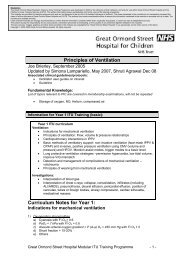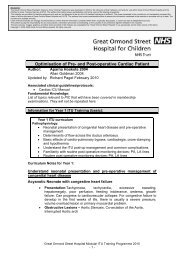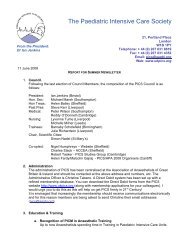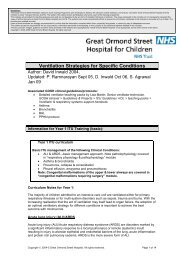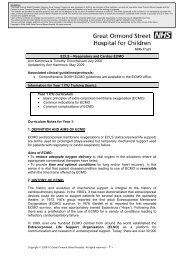Renal Replacement Therapy & Plasmapheresis Quen Mok ... - PICS
Renal Replacement Therapy & Plasmapheresis Quen Mok ... - PICS
Renal Replacement Therapy & Plasmapheresis Quen Mok ... - PICS
Create successful ePaper yourself
Turn your PDF publications into a flip-book with our unique Google optimized e-Paper software.
Great Ormond Street Hospital Modular ITU Training Programme 2008-2009<br />
• Clearance of drugs especially if low protein binding<br />
• Hypotension from excessive fluid loss or clearance of inotropes<br />
• Malnutrition from clearance of many amino acids – this may be reduced if nutrition is<br />
optimized during RRT.<br />
Other sources of information:<br />
Websites:<br />
Peds CRRT website www.pcrrt.com<br />
Acute Dialysis Quality Initiative group website www.ADQI.net<br />
References:<br />
1. Quan A and Quigley R. <strong>Renal</strong> replacement therapy and acute renal failure. Curr Opin<br />
Pediatr 2005; 17:205-9<br />
2. Kellum JA, Angus DC, Johnson JP et al. Continuous versus intermittent renal<br />
replacement therapy: a meta-analysis. Intensive Care Med 2002; 28: 29-37<br />
3. Schetz M. Anticoagulation for continuous renal replacement therapy Curr Opin<br />
Anaeathesiol 2001; 14:143-9<br />
Information for Year 2 ITU Training (advanced):<br />
Year 2 ITU curriculum<br />
Continuous veno-venous haemofiltration:<br />
Complete understanding of<br />
• Indications, contra indications and complications<br />
• Principles of fluid and electrolyte control: flow rate, % filtration fraction and fluid<br />
balance.<br />
<strong>Plasmapheresis</strong>:<br />
• Indications, contraindications and complications<br />
• Need to replace immunoglobulin<br />
Haemodialysis:<br />
• Indications, contra indications and complications<br />
• Haemodynamic effects.<br />
Curriculum Notes for Year 2:<br />
CVVH<br />
Increased solute clearance by<br />
• Bigger filters with larger membrane surface area<br />
• Increased blood flow rate Qb through filter<br />
• Increased ultrafiltration rate Qf<br />
• Addition of countercurrent dialysis (CVVHD), to a certain extent<br />
The comparison of CVVH with CVVHD or CVVHDF (CVVH with countercurrent dialysate flow<br />
or continuous veno-venous haemodiafiltration) shows that all are equally effective [4,5]. We<br />
tend to use CVVH in PICU as we have managed effective solute clearance with large filters<br />
and by adjusting blood flows and filtration fractions. Higher ultrafiltration rates (35 or 45<br />
ml/kg/h compared to 20 ml/kg/h) improved survival significantly [6]. Early institution of RRT<br />
Copyright © 2008-9 Great Ormond Street Hospital. All rights reserved. - 6 -



